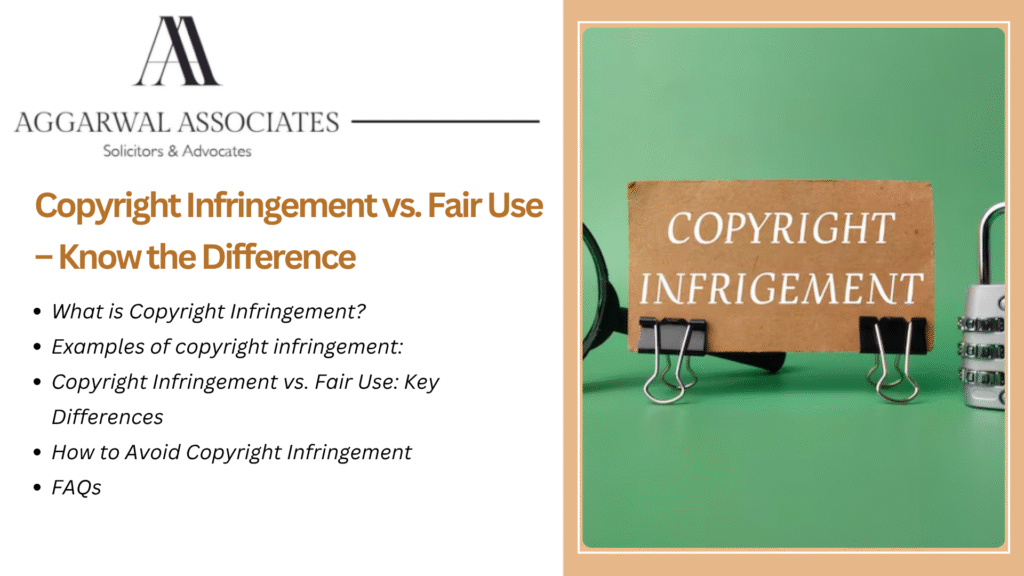In today’s digital world—where content is shared, reposted, and remixed at lightning speed—it’s more important than ever to understand the difference between copyright infringement and fair use. Whether you’re a content creator, educator, marketer, or just an everyday internet user, knowing where the legal lines are drawn can save you from hefty fines and take-down notices.

Let’s break it all down in a clear and simple way.
What is Copyright Infringement?
Copyright infringement happens when someone uses someone else’s original creative work—like a photo, video, song, book, or even code—without permission from the copyright holder. It doesn’t matter whether you profit from it or not; unauthorized use can still count as infringement.
Read More: Copyright Infringement in India | Copyright Infringement Law Firm in India | Copyright Infringement Lawyer in India
Examples of copyright infringement:
- Uploading someone else’s song or video to YouTube without permission
- Using stock photos on your blog without a proper license
- Copy-pasting large chunks of text from a copyrighted book
Legal consequences can range from cease-and-desist letters and removal requests (DMCA takedowns) to fines or lawsuits that cost thousands of dollars.
What is Fair Use?
Fair use is a legal doctrine that allows limited use of copyrighted material without permission from the creator—but only under specific conditions. In the U.S., fair use is protected under Section 107 of the Copyright Act (1976).
Fair use is often claimed when the copyrighted material is used for:
- Commentary or criticism
- News reporting
- Education or research
- Parody or satire
But just calling something “fair use” doesn’t make it so. You must consider the four factors of fair use.
The Four Factors of Fair Use
- Purpose and Character of the Use
- Is it commercial or educational?
- Is it transformative—meaning, did you add new meaning, context, or message?
- Nature of the Copyrighted Work
- Is the original work factual or creative?
- Using factual work (like news reports) is more likely to qualify as fair use.
- Amount and Substantiality
- How much of the work was used?
- Using smaller portions is more favorable, unless you took “the heart” of the work.
- Effect on the Market
- Does your use harm the market value of the original work?
⚖️ All four factors must be weighed together—no single one determines fair use.
Copyright Infringement vs. Fair Use: Key Differences
| Aspect | Copyright Infringement | Fair Use |
|---|---|---|
| Permission | Not obtained | Not required (under strict limits) |
| Intent | Often commercial or unauthorized | Often educational, critical, or transformative |
| Legal Protection | Illegal, can lead to lawsuits | Legal (if it meets fair use criteria) |
| Market Impact | Can damage the original creator’s value | Should not harm the market |
👉 Key takeaway: Giving credit does NOT make your use fair—context and purpose matter more.
Real-World Examples
✅ Fair Use:
- Google Books: Scanned books for searchable indexes—allowed as fair use because it was transformative and didn’t replace the original.
- Campbell v. Acuff-Rose Music, Inc.: A parody of a Roy Orbison song was ruled fair use due to its transformative nature.
❌ Copyright Infringement:
- Uploading full movie clips on TikTok or YouTube without edits or commentary.
- Copying articles word-for-word for a blog.
International Comparison: Fair Use vs. Fair Dealing
While fair use is a U.S. concept, other countries use similar but different frameworks like fair dealing:
| Country | Legal Term | Scope |
|---|---|---|
| USA | Fair Use | Broad and flexible, based on 4-factor test |
| UK/India/Canada | Fair Dealing | More limited; specific purposes only |
In India, for example, fair dealing allows use for criticism, review, or private study—but not for parody or satire.
How to Avoid Copyright Infringement
Here are smart tips to protect yourself:
- ✅ Use royalty-free or Creative Commons content
- ✅ Get proper licenses from stock sites or creators
- ✅ Create your own original material
- ✅ Add commentary or transformation to support fair use
- ✅ Consult legal experts if in doubt
Tools like Google Image Search, TinEye, and Copyscape can help identify copyrighted content before you use it.
Summary: Why It Matters
Understanding copyright infringement vs. fair use is essential in today’s content-saturated world. Not everything online is free to use, and not every use counts as fair use.
Before you reuse, remix, or repost—ask yourself:
“Am I transforming this work? Could this hurt the original creator’s market?”
Respecting creative ownership builds your credibility, protects you legally, and supports the content ecosystem we all rely on.
FAQs about Copyright Infringement vs. Fair Use
What is an example of copyright infringement?
Using a full copyrighted song in your YouTube video without permission or commentary is copyright infringement.
How can I tell if something is fair use?
Consider the four factors: purpose, nature, amount, and market effect. If it’s educational, transformative, and doesn’t hurt the original market, it may qualify.
Does giving credit make it fair use?
No. Giving credit is respectful but does not replace the need for permission or fair use evaluation.
What’s the difference between fair use and fair dealing?
Fair use (U.S.) is broader and more flexible. Fair dealing (India, UK, Canada) is more limited and applies only in specific cases like research, private study, or criticism.
